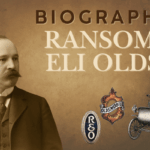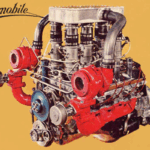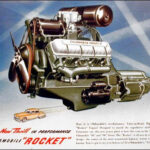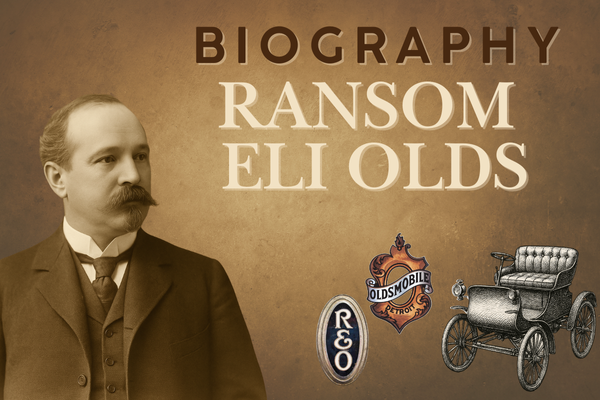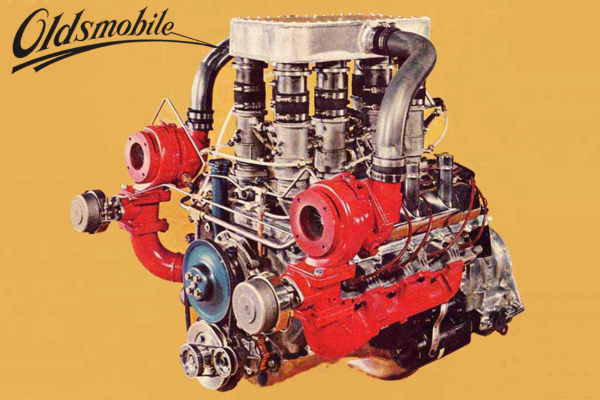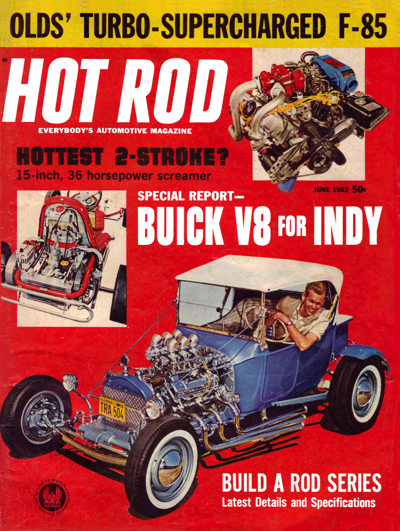The 260 and 289 “Windsor” small-block Ford engine used a thin-wall cast iron block with a separate timing chain cover, made from aluminum. This feature differentiates it from later “Cleveland”, or “335-series” engines, that used an integrated timing cover cast into the block. All Windsors used standard ohv 2-valve per cylinder heads regardless of whether they are “2 or 4-barrel engines. The valves are in-line and use 6-bolt valve covers.
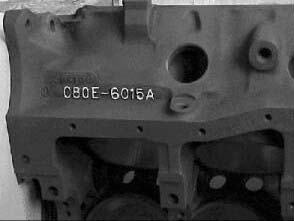

Location of small block cylinder head casting number.
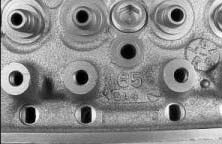
Location of cylinder head date code
Another differentiator between the Windsor and Cleveland series is the location of the radiator hose, as the Windsor routed its coolant through the intake manifold, with the hose protruding horizontally, while the Cleveland had the radiator hose connected vertically – directly to the engine block.
The heads on the 260-289 are similar, whereas the Cleveland engines used a canted valve design similar to the Chevrolet big block, allowing for larger valves. Though quite different in head and in many water passages in the front of the block, Ford Engineers designed the Cleveland heads with the same bore spacing and head bolt configuration making it possible with some machine work to bolt Cleveland heads to the Windsor block. A such, in 1969, they did that and created the “Boss 302”, which is neither totally a Cleveland engine nor a Windsor.
With the heads removed, the 260 will show a 3.80″ bore, and the 289 will have a 4.00″ bore, which would consistant throughout the life of this motor – all the way through the 302 versions and the later 5.0 Liter engine. The 221 cu. in. engine has a 3.5″ bore.
Another way to identify the 260-289 engine is the oil routing. The oil routing in the block is unique in that a third oil passage is drilled parallel to the tappet passages. This passage insures that oil reaches the main and cam bearings before the lifters, reducing the likelihood of oil starvation of the bearings. The 351 Cleveland and the 385 series engines do not have this feature. In the 260-289, the lifters are fed from and inverted “V” passage cast in the rear and under the intake manifold that connects with this third oil passage and is sealed with steel cap. The third oil passage is also visible from the rear of the block. It is under and slightly right of the right bank lifter passage.
Casting Numbers
Block Casting Numbers
There is no code stamped on the block itself that identifies the cubic inch displacement of the block. Casting numbers can be helpful in identifying the year of production, but not the actual displacement. Engine displacements are identified by a tag attached to the engine underneath the coil attaching bolt, which may be lost or missing.
The 221, 260, 289 engines were originally designed for the Ford Fairlane and produced only in the Cleveland engine plant from 1962-1965. However, the Falcon and Mustang as well as the Shelby Cobra used this early block.
In 1964 the casting number for all 260-289s was C4OE-6015-C. Some later 289 engines used an “F” suffix. In 1965, only the 289 was produced and this number was changed to C5AE-6015-E for the 2V, 4V and Hi-Po engines. The change in casting allowed these engines to now fit all Ford vehicles. As a result, this casting number was the full-sized Ford designation type and used a 6-bolt bell housings rather thanthe earlier 5-bolt. In mid-year 1966 the Windsor plant also began producing 289 series blocks. The casting numbers for these were C6AE-6015-C with a “289” and “WF” in the lifter valley.
In 1967 both Cleveland and Windsor foundries produced 289s using earlier year casting numbers but with updated date codes. These two blocks were interchangeable in vehicle usage, but there were some minor differences. Near the end of the 1967 production run, Cleveland ran out of 289 blocks and substituted the new 302 block, C8-OE-6015-A and marked with “302” in the lifter valleys. This block wasn’t intended to see action until 1968. The 302 casting numbers returned to the intermediate size Ford or Fairlane lineage. Hence, a late model 289 coming from the Cleveland plant might have a 302 block with 289 innards.
The Windsor plant had an abundance of 289 blocks for 1967. In 1968 Cleveland only made 302s, while Windsor continued with the 289s. It appears Windsor also tooled up for 302s but the plug was pulled before they got to make any. They did however, design and produce a 302 block that was used on 289s after the stock of 289 blocks were depleted. That casting number was C8AE-6015-B, but it did have “302” marked in the lifter valley. At the very end of the model year some additional 289 blocks must have been discovered as the older C6AE-6015-C blocks appeared again.
In 1969 Cleveland continued with 302 production but Windsor dropped its 289 production and cast high-deck 351s. In 1970, the Cleveland plant began production of the newly designed 351.
Regarding the use of 302 blocks for 289s:
- C8AE-6015-B is a 302 block from the Windsor plant – used in 1968 on a 289.
- C8OE-6015-A is a 302 block from the Cleveland plant – used for a 1967 289 or a 1968 or later 302 (you must check the date code)
Engine ID Code
There is no code stamped on the block itself that identifies the cubic inch displacement of the block. Casting numbers can be helpful, but some blocks used several different casting numbers. Engines are identified by a tag attached to the engine. This tag is used on all late 1964-1970 models and located under the coil attaching bolt. On the tag is the displacement, assembly plant, model year, change level, engine code, which is useful in identifying high performance models, and date of production. This tag is easily lost or replaced with a fake tag, so don’t rely solely on the tag for identification. Use bore and stroke measurements to identify the block’s displacement after the year is determined from the casting code.
Cylinder Head ID
Casting numbers for cylinder heads may change from year to year. For example, the code may be cast as C6ZZ-A in 1966 and C8ZZ-A in 1968 even though they are the same cylinder head. Special heads are required with emission controls from 1965-1966 for the emission system to operate properly. Beginning in 1967, all heads have provisions for emission control systems. Casting numbers are usually the same or nearly the same as the part number. Cylinder heads cast with a “5” as the second digit were most likely installed in a 1966 model.
With the exception of the 289 HiPo, Boss 302 and 351cubic inch “Windsor”, all 260-289 engine connecting rods use the same 5/16″ diameter bolts which were known to fail under high RPM operation. The rod forgings have undergone changes throughout history. The 221, 260 and early 289 (C2OZ-A and C3AE-D) rods used an oil squirt hole to lubricate the piston pin and rings. The oil squirt hole was discontinued in 1964, because of excessive oil consumption. The same forging (less the squirt hole) continued to be used up to 1967 and all were the same length at 5.155″.
The 302 used a shorter beam C8OE-A rod, due to it’s longer stroke @ 5.090″, but it used the same rod cap initially – through 1970. In 1971 the cap design was changed from flanged to flat. This was changed back to the flange design in 1988 due to fatigue failures from increased power output of the 5.0’s fuel injection power output and continued until the end of production.
The 289 Hi-Po and Boss 302 used the same rod length at 5.155″, but they were heavier beam and cap forgings, with 3/8″ bolts. They were also machined differently. The 289 Hi-Po used square head bolts and square cut caps. The Boss 302 caps were spot faced for “football head” head bolts.



